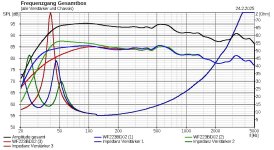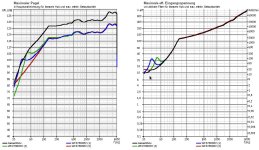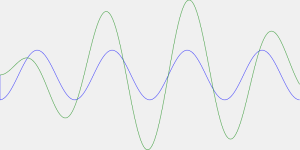Hallo,
I have a question about max SPL with bassreflex and closed boxes.
I tried to calculate a ~70L boxes with Wavecor WF223BD in BoxSim and suprised by the output.
As you can see in the images, I've added 3 such speakers in a 40cm box, one closed (red), one BR tuned to 30Hz (blue), and one tuned to 40Hz (green). In the efficiency plot, the blue plot looks good.
For the maxSPL plot, I've set the max themal power of the speakers to above 1000W, to make sure we see Xmax-limited results. Just as I'd expect, details like volume of the box drop their influence on max SPL then.
But isn't only about 97 db max SPL @50hz a suprisingly low number for a bass of that size? And how does BR manage to get ~12dB maxSPL more @fb given an Xmax limit? Wouldn't +6dB be the outcome to expect?
I have a question about max SPL with bassreflex and closed boxes.
I tried to calculate a ~70L boxes with Wavecor WF223BD in BoxSim and suprised by the output.
As you can see in the images, I've added 3 such speakers in a 40cm box, one closed (red), one BR tuned to 30Hz (blue), and one tuned to 40Hz (green). In the efficiency plot, the blue plot looks good.
For the maxSPL plot, I've set the max themal power of the speakers to above 1000W, to make sure we see Xmax-limited results. Just as I'd expect, details like volume of the box drop their influence on max SPL then.
But isn't only about 97 db max SPL @50hz a suprisingly low number for a bass of that size? And how does BR manage to get ~12dB maxSPL more @fb given an Xmax limit? Wouldn't +6dB be the outcome to expect?
Attachments
According to loadspearkerdatabase.com, max SPL@50Hz in closed Box is 99dB (for both WF223BD versions, Xmax +/-6,5mm), also independent of volume, according to their CB sim.
Maybe Visaton's BoxSim just uses some 2dB more conservative assumption about wave coupling there.
The plots include a simple crossover with 3 mH, 1 Ohm.
Baffle step correction was turned on (but when turned off, the +12dB instead of the +6dB relative to closed Box "problem"/question remains).
Maybe Visaton's BoxSim just uses some 2dB more conservative assumption about wave coupling there.
The plots include a simple crossover with 3 mH, 1 Ohm.
Baffle step correction was turned on (but when turned off, the +12dB instead of the +6dB relative to closed Box "problem"/question remains).
At Fb the driver cone barely moves, the sound output comes mostly from the bass reflex port.And how does BR manage to get ~12dB maxSPL more @fb given an Xmax limit?
Because of that the BR enclosure has a higher possible output at and around its tuning frequency.
The added possible SPL depends mostly from the tuning and the Qb.
For sealed enclosures the max SPL has a 12 dB slope.
Going down one octave requires the quadruple air displacement.
Only increasing air displacement or reducing radiation angle will increase the possible SPL (for sealed enclosure).
Last edited:
For max_SPL, many dynamic effects totally disappear...
The point is moving a 213 cm² cone by 6.5mm always gives 0.13845 L of displaced air on both sides of the cone, and if that amount of pushed air gives an SPL of SPL_p1 (for a closed box), how could maximally that same amount from the back-side of the cone behave like if it was 3 times more air to give an overall SPL_p12 = SPL_p1 +12dB?
The point is moving a 213 cm² cone by 6.5mm always gives 0.13845 L of displaced air on both sides of the cone, and if that amount of pushed air gives an SPL of SPL_p1 (for a closed box), how could maximally that same amount from the back-side of the cone behave like if it was 3 times more air to give an overall SPL_p12 = SPL_p1 +12dB?
It's a misconception that a bass reflex enclosure works by the back of the driver simply pushing air through the vent.how could maximally that same amount from the back-side of the cone behave like if it was 3 times more air to give an overall SPL_p12 = SPL_p1 +12dB?
At tuning frequency the driver only excites the box resonance and will barely move.
It's like a dad (or mum...) pushing a child on a swing - the energy in each push impulse is much less than the total energy accumulated by the child on the swing.
Obviously. Even for a closed box, it might be much easier for the driver to work against the minor pressure just generated in front of it than to (de)compress a finite inside volume (to possibly much higher pressure). And this front-part work might even get less when taking into account that normal air movement stuck to the cone would contribute moving mass (and as such, during a full cycle, sometimes making it easier and sometimes harder for the cone to move).
But to my understanding, there's something like a virtual sphere (of a fixed fraction of wavelength) around the speaker, that "gets filled" proportionally to the forementioned "volume of air pushed", where "getting filled" would be equivalent to pressure and omnidirectional SPL.
So this would mean that my "the vent moves maximally as much air as the cone moves"-thesis is incompatible with calculation results claiming that vent-SPL can be higher than cone-SPL (a frequently found assumption).
But to my understanding, there's something like a virtual sphere (of a fixed fraction of wavelength) around the speaker, that "gets filled" proportionally to the forementioned "volume of air pushed", where "getting filled" would be equivalent to pressure and omnidirectional SPL.
So this would mean that my "the vent moves maximally as much air as the cone moves"-thesis is incompatible with calculation results claiming that vent-SPL can be higher than cone-SPL (a frequently found assumption).
What about a fixed Helmholtz resonator volume with 2 identical vents, except that one of which is actively controlled by a cone?
Whatever the final phase of the passive vent, why should it move more air (in a full cycle) than the controlled one?
Whatever the final phase of the passive vent, why should it move more air (in a full cycle) than the controlled one?
Great, looks like I'm wrong.
I've made a simple simulation script that shows me (modulo probable bugs) that vented air amount can get higher (much higher at fb, I think). But it also shows some addition (of fb?) at other frequencies. Given that (at least intended) style of simulation is something I really trust, the prob is probably solved.
I've made a simple simulation script that shows me (modulo probable bugs) that vented air amount can get higher (much higher at fb, I think). But it also shows some addition (of fb?) at other frequencies. Given that (at least intended) style of simulation is something I really trust, the prob is probably solved.
Attachments
Your simulation looks good! I measured output of driver and vent here:
https://www.diyaudio.com/community/...ox-woofers-out-of-fashion.412687/post-7684005
https://www.diyaudio.com/community/...ox-woofers-out-of-fashion.412687/post-7684005
But the added resonant freq might be a bit suspicious.
Not sure if this tendency would disappear with concepts of losses modeled into the script.
Not sure if this tendency would disappear with concepts of losses modeled into the script.
- Home
- Design & Build
- Software Tools
- Bassreflex max SPL in BoxSim


